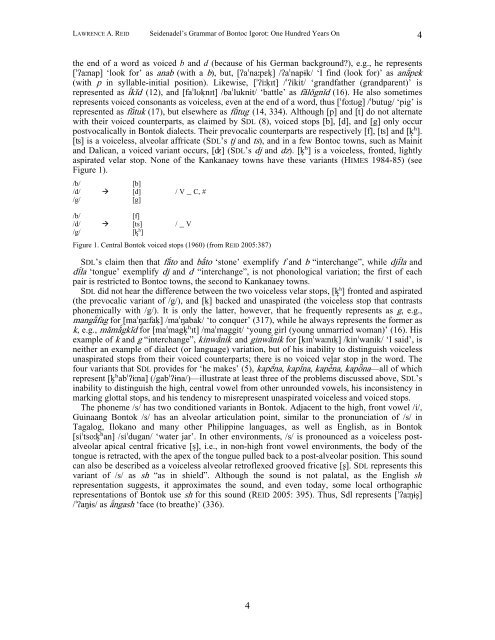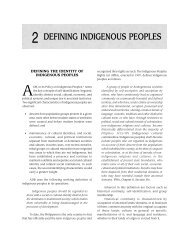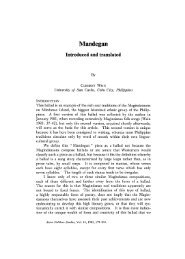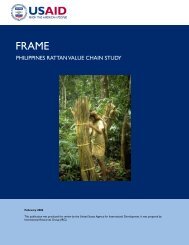1 Seidenadel's Grammar of Bontoc Igorot: One Hundred Years On
1 Seidenadel's Grammar of Bontoc Igorot: One Hundred Years On
1 Seidenadel's Grammar of Bontoc Igorot: One Hundred Years On
- No tags were found...
You also want an ePaper? Increase the reach of your titles
YUMPU automatically turns print PDFs into web optimized ePapers that Google loves.
LAWRENCE A. REID Seidenadel’s <strong>Grammar</strong> <strong>of</strong> <strong>Bontoc</strong> <strong>Igorot</strong>: <strong><strong>On</strong>e</strong> <strong>Hundred</strong> <strong>Years</strong> <strong>On</strong> 4<br />
the end <strong>of</strong> a word as voiced b and d (because <strong>of</strong> his German background), e.g., he represents<br />
[ˈʔaːnap] ‘look for’ as anab (with a b), but, [ʔaˈnaːpɛk̩] /ʔaˈnapɨk/ ‘I find (look for)’ as anāṕek<br />
(with p in syllable-initial position). Likewise, [ˈʔiːk̩ɪt] /ˈʔikit/ ‘grandfather (grandparent)’ is<br />
represented as īḱǐd (12), and [faˈlʊk̩nɪt] /baˈluknit/ ‘battle’ as fǎlǒgnǐd (16). He also sometimes<br />
represents voiced consonants as voiceless, even at the end <strong>of</strong> a word, thus [ˈfoːtʊg] /ˈbutug/ ‘pig’ is<br />
represented as fū́tuk (17), but elsewhere as fū́tug (14, 334). Although [p] and [t] do not alternate<br />
with their voiced counterparts, as claimed by SDL (8), voiced stops [b], [d], and [g] only occur<br />
postvocalically in Bontok dialects. Their prevocalic counterparts are respectively [f], [ʦ] and [k̟ʰ].<br />
[ʦ] is a voiceless, alveolar affricate (SDL’s tj and ts), and in a few <strong>Bontoc</strong> towns, such as Mainit<br />
and Dalican, a voiced variant occurs, [ʣ] (SDL’s dj and dz). [k̟ʰ] is a voiceless, fronted, lightly<br />
aspirated velar stop. None <strong>of</strong> the Kankanaey towns have these variants (HIMES 1984-85) (see<br />
Figure 1).<br />
/b/<br />
[b]<br />
/d/ [d] / V __ C, #<br />
/g/<br />
[g]<br />
/b/<br />
[f]<br />
/d/ [ts] / __ V<br />
/g/ [k h ]<br />
Figure 1. Central Bontok voiced stops (1960) (from REID 2005:387)<br />
SDL’s claim then that fā́to and bā́to ‘stone’ exemplify f and b “interchange”, while djīĺ and<br />
dīĺa ‘tongue’ exemplify dj and d “interchange”, is not phonological variation; the first <strong>of</strong> each<br />
pair is restricted to <strong>Bontoc</strong> towns, the second to Kankanaey towns.<br />
SDL did not hear the difference between the two voiceless velar stops, [k h ] fronted and aspirated<br />
(the prevocalic variant <strong>of</strong> /g/), and [k̩] backed and unaspirated (the voiceless stop that contrasts<br />
phonemically with /g/). It is only the latter, however, that he frequently represents as g, e.g.,<br />
mangā́fag for [maˈŋaːfak̩] /maˈŋabak/ ‘to conquer’ (317), while he always represents the former as<br />
k, e.g., mǎmǎǵkǐd for [maˈmagk̟ʰɪt] /maˈmaggit/ ‘young girl (young unmarried woman)’ (16). His<br />
example <strong>of</strong> k and g “interchange”, kinwāńik and ginwāńik for [k̩ɪnˈwaːnɪk̩] /kinˈwanik/ ‘I said’, is<br />
neither an example <strong>of</strong> dialect (or language) variation, but <strong>of</strong> his inability to distinguish voiceless<br />
unaspirated stops from their voiced counterparts; there is no voiced velar stop in the word. The<br />
four variants that SDL provides for ‘he makes’ (5), kapḗna, kapīńa, kapė̄ńa, kapȫ ́na—all <strong>of</strong> which<br />
represent [k̟ʰabˈʔɨːna] (/gabˈʔɨna/)—illustrate at least three <strong>of</strong> the problems discussed above, SDL’s<br />
inability to distinguish the high, central vowel from other unrounded vowels, his inconsistency in<br />
marking glottal stops, and his tendency to misrepresent unaspirated voiceless and voiced stops.<br />
The phoneme /s/ has two conditioned variants in Bontok. Adjacent to the high, front vowel /i/,<br />
Guinaang Bontok /s/ has an alveolar articulation point, similar to the pronunciation <strong>of</strong> /s/ in<br />
Tagalog, Ilokano and many other Philippine languages, as well as English, as in Bontok<br />
[siˈtsoːk̟ʰan] /siˈdugan/ ‘water jar’. In other environments, /s/ is pronounced as a voiceless postalveolar<br />
apical central fricative [s̟], i.e., in non-high front vowel environments, the body <strong>of</strong> the<br />
tongue is retracted, with the apex <strong>of</strong> the tongue pulled back to a post-alveolar position. This sound<br />
can also be described as a voiceless alveolar retr<strong>of</strong>lexed grooved fricative [ʂ]. SDL represents this<br />
variant <strong>of</strong> /s/ as sh “as in shield”. Although the sound is not palatal, as the English sh<br />
representation suggests, it approximates the sound, and even today, some local orthographic<br />
representations <strong>of</strong> Bontok use sh for this sound (REID 2005: 395). Thus, Sdl represents [ˈʔaːŋɨʂ]<br />
/ˈʔaŋɨs/ as āńgash ‘face (to breathe)’ (336).<br />
4

















